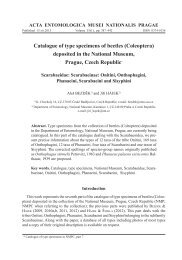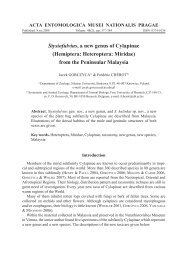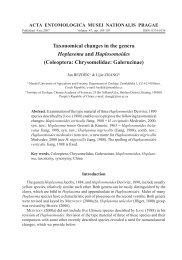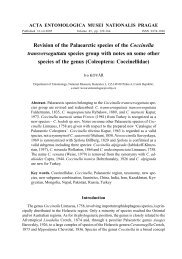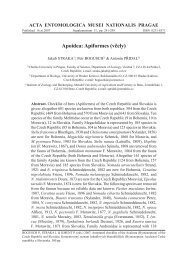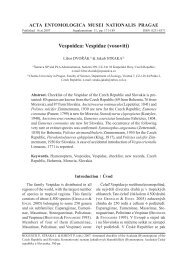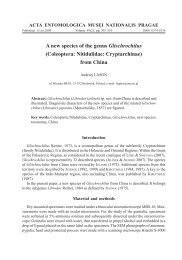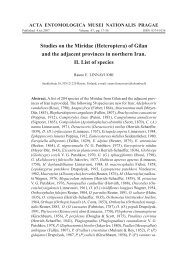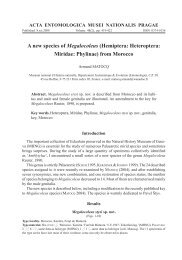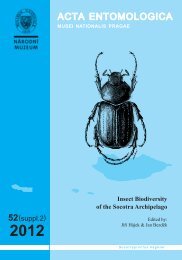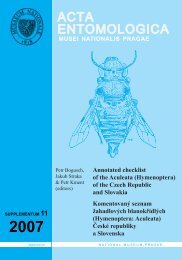Hemiptera: Heteroptera: Aradidae - Acta Entomologica Musei
Hemiptera: Heteroptera: Aradidae - Acta Entomologica Musei
Hemiptera: Heteroptera: Aradidae - Acta Entomologica Musei
Create successful ePaper yourself
Turn your PDF publications into a flip-book with our unique Google optimized e-Paper software.
<strong>Acta</strong> <strong>Entomologica</strong> <strong>Musei</strong> Nationalis Pragae, 53(1), 2013 37<br />
callosities on inner half, laterally rugose; posterolaterally produced tubercles of deltg VI and<br />
VII. Due to the displaced segments VIII+IX no structural details can be given.<br />
Venter. Prosternum with a triangular median elevation, fused to meso- and metasternum<br />
and sternite II, fusion lines marked by transverse sutures; median plate of meso-metasternum<br />
and sternite II with a shallow depression; sternites III–VII separated by distinct sutures,<br />
surface of sternites III–VI smooth in middle, lateral parts and pleural regions of thorax with<br />
rugosities; spiracles II placed on a lateral tubercle and visible from above, III+IV sublateral<br />
and hardly visible, V lateral and visible, VI and VII apical on prominent posterolateral angles,<br />
VIII terminal on paratergites VIII.<br />
Legs. Middle and hind femora with long preapical spines, tibiae cylindrical, tarsi twosegmented,<br />
claws with long pulvilli.<br />
Measurements. Body length 5.1 mm; length / width ratio of mesonotum 0.5 / 1.6 mm,<br />
width of metanotum 1.55 mm; length / width ratio of mtg I+II 0.7 / 1.5 mm; length / width<br />
ratio of tergal plate 1.15 / 1.45 mm; width of abdomen across tergites: II – 2.25 mm, III – 2.30<br />
mm, IV – 2.305 mm, V – 2.30 mm, VI – 2.1 mm, VII – 1.6 mm.<br />
Differential diagnosis. Only one species is described in the apterous Carventinae genus<br />
Tiomanaptera (HEISS 2010b) – T. malickyi (Figs 2, 4, 7, 8) from the Tioman Island east of<br />
mainland Malaysia. The new species shares with that species the general habitus and femora<br />
armed with distinct preapical spines. It differs, however, from the latter in shorter genae,<br />
longer neck, strongly elevated median ridge of meso- and metanotum and fused mtg I+II,<br />
and in more distinct apodemal impressions on tergal plate.<br />
Etymology. The species is named in honour of our friend and collector of this interesting species,<br />
Dr. Peter Schwendinger, curator at the Muséum d’histoire naturelle de la Ville de Genève.<br />
Habitat. The single specimen of T. schwendingeri sp. nov. was sifted in primary rainforest<br />
close the footpath along tiny stream.<br />
Distribution. West Malaysia, Perhentian Besar Island, largest island from group of Perhentian<br />
Islands.<br />
Discussion<br />
In <strong>Aradidae</strong>, the elongate cylindrical neck is shared only by the Oriental Carventinae<br />
genera Apteraradus and Tiomanaptera. Considering the variation in size and body structures<br />
among the 6 species of Apteraradus described to date (KORMILEV & FROESCHNER 1987), the<br />
striking difference between these two genera is in the presence of spines on middle and hind<br />
femora of both sexes in Tiomanaptera; they are missing in Apteraradus. As the new species<br />
was collected also on an island east of mainland Malaysia (Berhentian Besar is about 380 km<br />
northwest of Tioman Island, the original locality of T. malickyi), the question may be rised if<br />
the development of femoral spines was related to isolated island conditions, or further species<br />
with this character are yet to be discovered in rainforests of mainland Malaysia.<br />
Acknowledgments<br />
We are grateful to Peter Schwendinger (Muséum d’histoire naturelle de la Ville de Genève)<br />
for the loan of the specimen and Jitka Vilímová (Charles University in Prague) and Lorène



